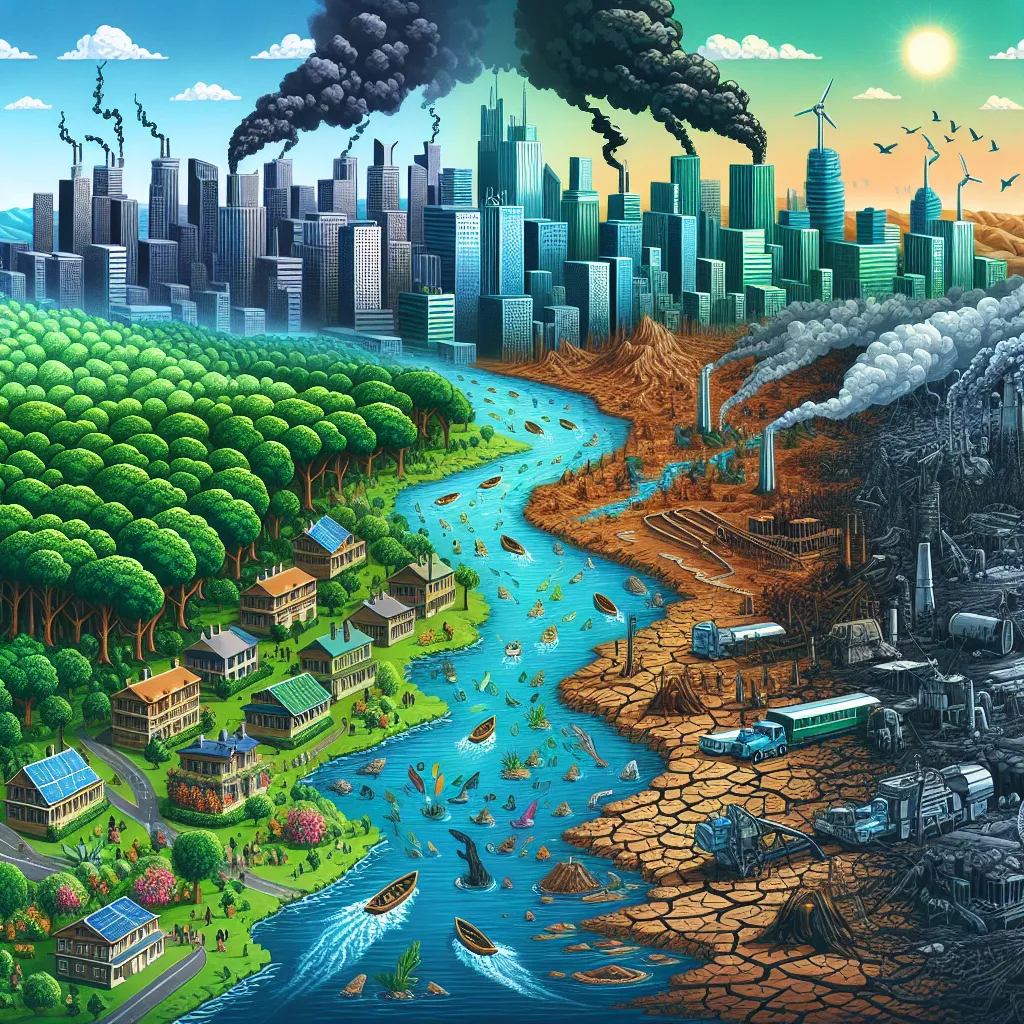Population growth and its effects on natural resources is a critical global issue that frequently appears in IELTS Writing Task 2 questions. This topic combines environmental concerns, social dynamics, and economic factors, making it a rich subject for discussion in academic writing. Let’s explore a sample question and provide model essays to help you tackle this challenging topic effectively.
Nội dung bài viết
Analyzing the Topic
The impact of population growth on natural resources has been a recurring theme in IELTS Writing Task 2, appearing in various forms over the past few years. Its relevance to current global challenges suggests it will likely continue to be a popular topic. Let’s examine a recent question that encapsulates this issue:
Some people believe that the rapid growth of the world’s population is the most serious threat to the natural environment. To what extent do you agree or disagree with this opinion?
This question asks you to consider the relationship between population growth and environmental degradation, requiring a nuanced approach to discuss the various factors at play.
Analyzing the Question
This question requires you to:
- Understand the claim that population growth is the most serious threat to the environment
- Evaluate the extent to which you agree or disagree with this statement
- Provide reasons and examples to support your position
- Consider other potential threats to the environment for a balanced argument
Sample Essays
Band 8-9 Essay
The exponential growth of the global population has undeniably put immense pressure on our planet’s natural resources. While I agree that this demographic trend poses a significant threat to the environment, I believe it is an oversimplification to label it as the most serious threat without considering other critical factors.
Population growth undoubtedly contributes to environmental degradation in several ways. Firstly, as the number of people increases, so does the demand for food, water, and energy, leading to overexploitation of natural resources. For instance, the expansion of agricultural land to feed growing populations has resulted in widespread deforestation, particularly in developing countries. Secondly, a larger population produces more waste and pollution, overwhelming ecosystems and contributing to climate change. The rapid industrialization of populous nations like China and India exemplifies how population growth can accelerate environmental damage through increased emissions and resource consumption.
However, it is crucial to recognize that population growth is not the sole, or necessarily the most serious, threat to the natural environment. Other factors, such as unsustainable consumption patterns in developed countries, play an equally significant role. For example, the United States, with less than 5% of the world’s population, consumes about 17% of the world’s energy and is responsible for approximately 15% of global CO2 emissions. This suggests that lifestyle and consumption habits can have a more pronounced impact on the environment than population numbers alone.
Moreover, technological advancements and policy decisions can significantly mitigate the environmental impact of population growth. Renewable energy technologies, sustainable agricultural practices, and efficient urban planning can help manage resources more effectively, even as populations expand. Countries like Germany and Denmark have demonstrated that it is possible to reduce environmental impact while maintaining high living standards through innovative policies and technologies.
In conclusion, while population growth is indeed a serious threat to the natural environment, it is not the only or necessarily the most critical factor. A holistic approach that addresses unsustainable consumption patterns, promotes technological innovation, and implements effective environmental policies is essential for managing the impact of human activities on our planet’s resources. The solution lies not in singling out population growth but in fostering a global commitment to sustainable development that balances human needs with environmental preservation.
(Word count: 365)
Band 6-7 Essay
The rapid increase in the world’s population is often seen as a major problem for the environment. While I partly agree that it is a serious issue, I don’t think it is the only or the biggest threat to our natural world.
On one hand, more people definitely means more pressure on the environment. As the population grows, we need more food, water, and energy. This leads to problems like cutting down forests for farming and using up water supplies. For example, in many developing countries, forests are being destroyed to make space for crops and houses. Also, more people produce more waste and pollution, which harm nature. The growing populations in countries like China and India have caused a big increase in pollution and the use of natural resources.
However, I believe there are other factors that are just as important, or even more so, in damaging the environment. One of these is the way people in rich countries live. Even though these countries don’t have the biggest populations, they use a lot more resources per person. For instance, people in the United States use much more energy and produce more waste than people in poorer countries. Another big problem is the lack of good environmental policies in many countries. If governments don’t make and enforce laws to protect nature, even a small population can cause a lot of damage.
Furthermore, new technologies can help us manage resources better, even with more people. Things like renewable energy and better farming methods can reduce the impact of population growth. Some countries have shown that it’s possible to have a good standard of living without harming the environment too much.
In conclusion, while population growth is a serious concern for the environment, it’s not the only big threat. We need to look at other issues like how we use resources and what policies we have. Solving environmental problems requires addressing multiple factors, not just focusing on population numbers.
(Word count: 320)
 Population impact on environment
Population impact on environment
Key Writing Tips
-
Structure: Both essays follow a clear structure with an introduction, body paragraphs, and a conclusion. The Band 8-9 essay demonstrates more sophisticated paragraph development and transitions.
-
Vocabulary: The higher band essay uses more advanced vocabulary and phrases, such as “exponential growth,” “demographic trend,” and “overexploitation.” The Band 6-7 essay uses simpler language but still maintains clarity.
-
Grammar: The Band 8-9 essay showcases a wider range of complex sentence structures, while the Band 6-7 essay uses simpler constructions but remains grammatically correct.
-
Task Response: Both essays address the question directly, but the Band 8-9 essay provides a more nuanced argument with well-developed examples and counterarguments.
-
Coherence and Cohesion: The higher band essay demonstrates better use of linking words and phrases to connect ideas smoothly.
Essential Vocabulary
- Exponential growth (noun) /ˌekspəˈnenʃəl ɡrōTH/ – Rapid increase
- Overexploitation (noun) /ˌōvərˌekˌsploiˈtāSH(ə)n/ – Excessive use of a resource
- Degradation (noun) /ˌdeɡrəˈdāSH(ə)n/ – Deterioration of the environment
- Sustainability (noun) /səˌstānəˈbilədē/ – Ability to maintain ecological balance
- Mitigation (noun) /ˌmidəˈɡāSH(ə)n/ – Reduction of the severity of something
- Consumption patterns (noun phrase) /kənˈsəm(p)SH(ə)n ˈpadərns/ – Ways in which resources are used
- Renewable energy (noun phrase) /rəˈn(y)o͞oəb(ə)l ˈenərjē/ – Energy from sources that are not depleted
- Urban planning (noun phrase) /ˈərbən ˈplaniNG/ – Development and design of urban areas
- Holistic approach (noun phrase) /həˈlistik əˈprōCH/ – Considering all aspects of a situation
- Sustainable development (noun phrase) /səˈstānəb(ə)l dəˈveləpmənt/ – Development meeting present needs without compromising future generations
Conclusion
The topic of managing the impact of population growth on natural resources is complex and multifaceted, making it an excellent subject for IELTS Writing Task 2. To excel in writing about this topic, focus on:
- Providing a balanced argument that considers multiple perspectives
- Using specific examples to support your points
- Demonstrating a range of vocabulary related to environment and demographics
- Structuring your essay clearly with well-developed paragraphs
- Using complex sentence structures and advanced linking phrases
Practice writing essays on related topics such as:
- The role of government policies in managing population growth and resource use
- The impact of urbanization on natural resources
- Balancing economic development with environmental conservation
We encourage you to write your own essay on the question provided and share it in the comments section. This practice will help you improve your writing skills and receive feedback from others preparing for the IELTS exam.
For more insights on related topics, check out our articles on how to manage the environmental impact of urban growth and the effects of urbanization on environmental sustainability.


